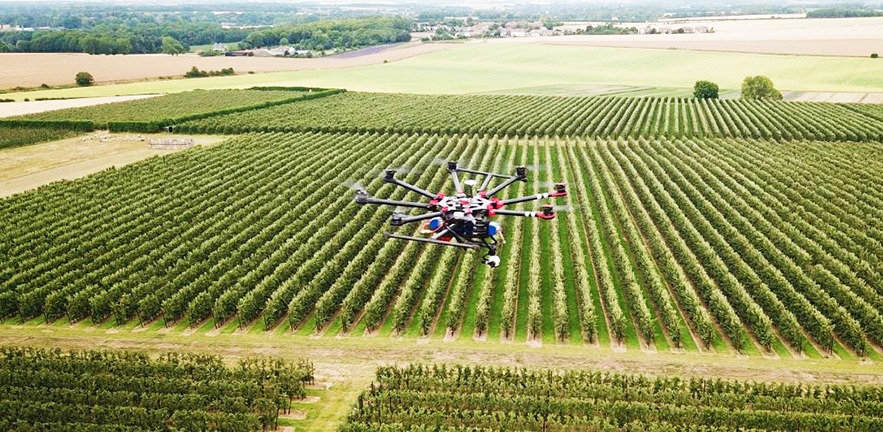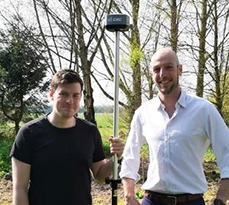Outfield Technologies, mentored at the Accelerate Cambridge programme at the Entrepreneurship Centre of Cambridge Judge Business School, uses drone technology to better predict the yields of apple producers.


Of all fruits, the apple has wormed its way most into our everyday dialogue: “an apple a day keeps the doctor away” and “the apple doesn’t fall far from the tree”, while another person might be a “bad apple” or the “apple of my eye”.
Although the apple may be “the noblest of fruits” (philosopher Henry David Thoreau), apple producers have for ages grappled with the humblest of problems: it’s devilishly difficult to predict the size of a harvest, and that’s pretty rotten for an apple grower’s bottom line.
A Cambridge-based startup called Outfield Technologies, which is associated with Cambridge Judge Business School, is addressing this issue through the use of drone technology, 3D computer imagery and artificial intelligence. By examining trees from 30 metres above ground in summer, about eight weeks from harvest, the drones’ high-resolution cameras and computer analysis of the photos provide a far better estimate of crop yield in September or October – and this can have a big impact on an apple producer’s financial performance.
“Even a day before harvest, a producer will only know the yield with about 80 per cent accuracy,” says Outfield co-founder and commercial director Jim McDougall. “Producers sell their crop well in advance to distributors, so they have to undersell by 20 per cent to ensure they can meet their commitments. That means the other 20 per cent is sold for pennies on the pound, or it’s simply left to rot as it’s not worth collecting. That was the case with the final apple harvest in the UK last year because Poland, which is a much larger producer than the UK, had a bumper harvest so juice prices were very low.”
Outfield was founded in 2016 by Jim McDougall and Oli Hilbourne, now operations director, and is currently on the Accelerate Cambridge mentoring programme run by the Entrepreneurship Centre at Cambridge Judge Business School. The company has won several grants, including £95,000 of a larger £575,000 crop-maximisation grant from government agency Innovate UK, and is currently working with partners such as the Cambridge-based plant sciences company NIAB (National Institute of Agricultural Botany), apple distributor Worldwide Fruit, and consultancy Hutchinson.
The Innovate UK grant is focused on drone-based analysis of apple blossoms at an early stage of growth, in order to guide growers to spray blossom-thinning chemicals more precisely. Apple trees with too many blossoms produce smaller apples at harvest time, while too few blossoms result in much larger apples that are difficult to sell as consumers are used to a certain size.
“We’re trying to resolve a problem apple growers have in the UK and all around the world,” says Charles Whitfield, Crop Protection Engineer at NIAB. “In a single apple orchard you get a lot of variation in neighbouring trees, so one tree might yield 50 kilograms of apples and the tree right next to it might only yield a few kilos. There’s a disconnect between trees, and year after year that difference can change from tree to tree.
“Growers who average out yield over the orchard may not notice, but if you look closely at the detail you can see how big those differences are, so we’re trying to smooth out those differences by targeting individual trees to receive the right amount of blossom-thinning agents. In the future, we hope that the same precision use of thinning agents for apple blossoms can be applied to other plant protection, so this would result in a reduction in the total amount of crop-protection product deployed.”
After operating as a consultancy for the past two years, Outfield plans to launch a commercial rollout of its drone-based service next year for crop estimates in 2021. The company says it’s now talking to 20 potential investors including industry partners and venture capital firms, with a goal of raising £1 million in early-stage funding in the first quarter of 2020. Initial target markets are the UK, South Africa and New Zealand, and the firm hopes to expand by 2024 to other crops including citrus, avocado and stone fruits such as peaches and plums.
“We haven’t launched the drone-based service yet commercially because we first wanted to be sure of the technology,” says Jim, who like co-founder Oli has a Masters in Engineering degree from Durham University, where they met. Besides the founders, the company now has six to eight employees or contractors (depending on the week), working on imagery analysis, front-end platform development, aerial surveying and financial assessment.
This year, Outfield and its UK Innovation grant partners worked on five trial orchards around the UK, where there are about 6,000 planted hectares of dessert apples (Gala, Braeburn and the like) and 3,000 hectares of cooking apples (Bramley); a UK apple-orchard hectare contains an average of 2,000 trees. Apple producers in Britain generally prune trees to 2.5 metres tall so the crop can be harvested by hand, and trees average between 40 and 120 apples each. Outfield is involved in eight similar trials in South Africa, where apple trees tend to be higher than in the UK.
“We’re very excited about this project and think this technology can do a lot for us,” says Chris Elworthy of Plumford Farms Ltd. in Faversham, Kent, about 45 miles southeast of London. “This is the first year of a three-year trial, but we’re really optimistic that this will prove really useful in knowing how many apples we’re going to pick, how much cold storage we need, and how many agricultural workers we’ll need for picking.”
The drone-based trial at Plumford Farms involves both blossom thinning at an early growth stage and the thinning of smaller apples at a later stage of the growing season in order to allow larger apples to thrive; traditionally, both procedures involve chemical spraying of trees based on orchard averages, rather than more targeted application.
“Our farm is a really good site to have a trial like this, because the principal orchard has a lot of tree variability, with some shaded and some in direct sunlight, and also elevation variation,” says Chris Elworthy. “We’re a small farm compared to others in the county, about 125 acres or over 100,000 apple trees, so this surveying technology will be even more valuable for bigger farms. This trial treats every tree in the orchard as an individual tree.”
Outfield says such greater precision lies at the core of its entire business plan. “The growers we talk to care more about monitoring their yield than growing their yield,” says Jim. “It’s no good growing more apples if you can’t sell them.”
This article is part of Venturing Forth, our series on the aspirations and challenges of ventures connected to students, alumni and others associated with Cambridge Judge Business School.

